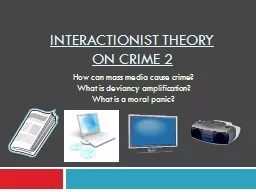

How can mass media cause crime What is deviancy amplification What is a moral panic Connector Watch the clip How are young people presented by the media httpwwwyoutubecomwatchvO5BvCje7nzgampfeaturechannel ID: 263656
Download Presentation The PPT/PDF document "Interactionist theory on crime 2" is the property of its rightful owner. Permission is granted to download and print the materials on this web site for personal, non-commercial use only, and to display it on your personal computer provided you do not modify the materials and that you retain all copyright notices contained in the materials. By downloading content from our website, you accept the terms of this agreement.
Slide1
Interactionist theory on crime 2
How can mass media cause crime?What is deviancy amplification?What is a moral panic?Slide2
Connector
Watch the clip.How are young people presented by the media?http://www.youtube.com/watch?v=O5BvCje7nzg&feature=channel Slide3
Objectives
All will be able to use the example of Mods and Rockers to explain how media can cause an increase in crime.Most will be able to explain how media representations of crime can lead to deviancy amplification and cause a moral panic. Some will be able to use a contemporary example to show how media cause an increase in crime. Slide4
Mass media and crime
Some argue that the mass media have an effect on our attitudes, values and behaviour. Currently, rap music, violent films and console games are being blamed for encouraging violence as people copy the deviant and criminal behaviour they see in the media.
Moreover, others claim that the media can actually cause an increase in crime simply by the way they report deviant events in, for example, the news. Slide5
Mods and Rockers
http://www.youtube.com/watch?v=r61ks18Bd7ISlide6
Mods and Rockers
Mods and Rockers, two youth cultures in the 1960s 1964Easter Bank holiday weekend A minor disturbance in ClactonCohenSlide7
Task 1
Read the handout.Write the key concepts and their definitions into your glossary. Answer these questions in full sentences:Who were Mods and Rockers?
Why did they start to be seen as folk devils and as causing social problems?
What were the consequences of media exaggeration of the events in Clacton on young people across Britain?How did the moral panic about the youth’s behaviour make things even worse? Slide8
Task 2
Cut out the cards.Arrange them in order to show how media representation of events causes a moral panic and an increase in crime – deviancy amplification.Slide9
Deviancy amplification and moral panic
A small group of people commit an act of deviance.
The media report the events, but the report exaggerates the seriousness of the events.
The story catches readers’ interest , more papers are sold and the viewing figures are increased by continuing the story.
The group is labelled as folk devils and stereotyping of any member of the group occurs.
A self-fulfilling prophecy happens and those identified as folk devils react to media coverage and commit more deviance.
A moral panic develops – the group that has been labelled as folk devils is seen as a threat to social order.
The police feel under pressure to deal with this social problem so they arrest anyone who ‘fits’ the stereotype of the folk devil. Slide10
Task 3
Use the example of youth knife crime to write sentences to show how a few incidents of knife crime has led to a moral panic about youth crime in Britain in the last few years. Slide11
Deviancy amplification and moral panic
A small group of people commit an act of deviance.
The media report the events, but the report exaggerates the seriousness of the events.
The story catches readers’ interest , more papers are sold and the viewing figures are increased by continuing the story.
The group is labelled as folk devils and stereotyping of any member of the group occurs.
A self-fulfilling prophecy happens and those identified as folk devils react to media coverage and commit more deviance.
A moral panic develops – the group that has been labelled as folk devils is seen as a threat to social order.
The police feel under pressure to deal with this social problem so they arrest anyone who ‘fits’ the stereotype of the folk devil.
A boy was stabbed in a scuffle with other boys.
The media reported the events, showing images of hooded youths.
The media continued to broadcast more stories linking teenagers to anti-social behaviour.
Teenagers are labelled as troublemakers.
Teenagers start to think that all teens carry knives and that they should too for protection. This leads some to get into trouble.
Teenagers are banned from shops, shops ban hooded tops and caps, etc.
The government sets up Trident. PCs are placed in schools, stop & search, etc. Slide12
Task 4
Work in a group of 3.Read the article and discuss these questions:Who is being made into folk devils by the article?
What language does the article use the present the events as a threat to society?
How might readers respond to articles like these ones? Would this response be fair?What might be the real cause of the problem that has been turned into a moral panic?
Who’s interests are served by clamping down on this type of crime?Would the Functionalists or the Marxists agree with your point of view?Slide13
Exam question
Identify one way in which the mass media might be said to bring about an increase in criminal behaviour and explain how this may happen.(5 marks)
One way through which the mass media could be said to bring about an increase in criminal behaviour is through… This involves…Slide14
Review
On the scrap of paper you are given, write a question about anything we’ve been learning in the Unit on Crime and deviance.Pass the piece to someone else. Now, answer the question someone’s passed to you.